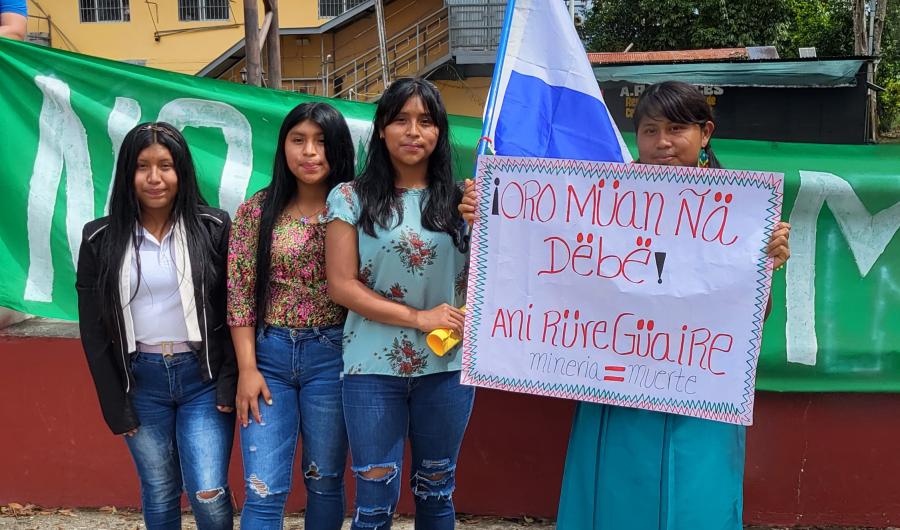The Ngobe villagers I visited in November in the Changuinola River valley in western Panama have survived for centuries by building lives for themselves in the country’s most remote terrain and avoiding confrontation with the dominant society. But rapid modernization now threatens their way of life, and avoidance is no longer a viable strategy. Their homes lie alongside the rivers that Panama wants to use to generate hydroelectric power for its energy-hungry urban areas. If the Ngobe don’t assert their rights now, their homes and farms will soon be swallowed up by huge new lakes created by hydroelectric dams.
I knew the Ngobe were suspicious of outsiders, and I was not sure what their reaction would be to yet another gringo coming along with promises of help and support. My wonderful colleague Lucia Lasso, an anthropologist at ACD (the Alliance for Conservation and Development, a Panamanian nongovernmental organization) suggested I bring along a copy of the “Land and Resources in Latin America” issue of Cultural Survival Quarterly (Winter 2006). While I was a little concerned about the extra weight—we were planning to backpack through a mud-drenched landscape in the midst of heavy rain (and I’m not in optimum shape)—I stuck a copy in my pack.
Shortly after arriving in the Ngobe village of Nance de Riscó, we visited the home of Elin Abrego, a Ngobe widow whose once-pristine view is now filled daily with giant Volvo earthmoving equipment. Instead of a sparkling clean river in which to wash her clothes and her grandchildren, she looks out over a brown ribbon of sediment-filled slush unfit for even her pigs to drink.
As I feared, despite warm introductions, Señora Abrego initially was reluctant to talk to me. But instead of interrogating her, I pulled out the Cultural Survival Quarterly and began showing her the pictures. She summoned her grandson to translate from Spanish to Ngobe the stories I was telling about each picture. She was impressed with the photo of Sidney Hill, Tadodaho Chief of the Haudenosaunee, speaking at the United Nations, and Elena Yach, a Mayan woman talking into a microphone at a Sololá, Guatemala, community radio station.
Then her jaw dropped. Looking at the photos of the gigantic Cerrejón coal mine on Colombia’s Guajira peninsula, and at the lake in the accompanying picture, she started talking about the fear she felt about the lake that would be created when the hydroelectric company had completed the dam on her river. She readily identified with the indigenous peoples from southern Peru whose lands are being invaded by illegal loggers, and pointed out how the cropped section of forest on Peru’s Sepahua River is a lot like the destruction she looks out upon.
But what moved Señora Abrego most was learning that, by speaking out in defense of their rights, the Diaguitas people of northern Chile were able to prevent a mining company from blasting away the top of their sacred mountain and the glacier that covered its peak. Something clicked, and I could tell that she had abandoned her strategy of avoidance and was ready to talk—and to fight.
As we moved along the river valley, talking with Ngobe families, we repeated the process, and each time, the outcome was the same. We showed them the magazine, and people who ordinarily are reticent to talk to strangers or engage in confrontation became friendly and then outspoken. They asked about their rights, and fortunately I’d also thought to pack a copy of the newly adopted UN Declaration on the Rights of Indigenous Peoples. Everyone wanted a copy.
The following day, representatives of the government and the dam company came to the Ngobe village of Charco la Pava. Instead of letting the government deliver its pre-packaged presentation and depart, the Ngobe villagers we had spoken with the day before captured the agenda and started to speak. One after another they asserted that they knew their rights and that the government and the company were violating them. They demanded protection for their lands and resources and full participation in decision making about their futures. They insisted that all construction in the region stop until a proper consultative process could take place.
Señora Abrego, who had never defied authority, was one of the first to speak. Clearly inspired by the example of other indigenous peoples she had seen in our magazine, she told them, “My land is for my children and my grandchildren. I need to save it for them. The company has sent the police to threaten me to sign their papers, but I won’t sign.”
Another woman, Señora Silvia, told the government, “Until now I have been silent, not because I wanted the dam; I have been silent because I didn’t know how to speak. Now I know how to do so.”
The Ngobe people have a long battle ahead of them. But they have taken the first step toward defending their rights, and from what I saw are unlikely to turn back. And, as I promised Señora Abrego and the other Ngobe villagers of Charco la Pava, Cultural Survival will be there with them, every step of the way.



